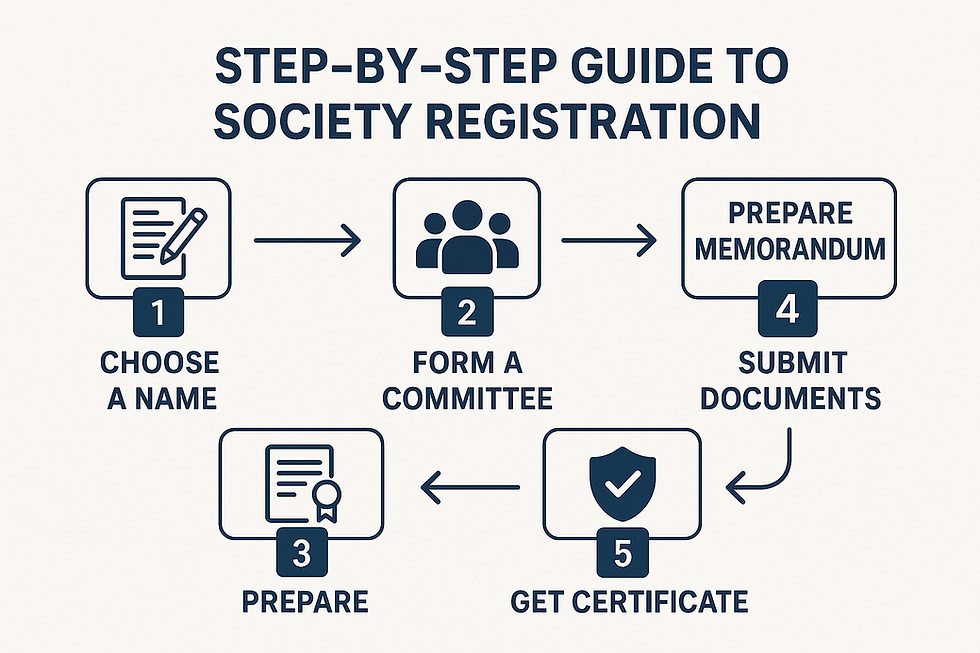Step-by-Step Guide to Society Registration in India
- LaxmiKant Palla
- Aug 22
- 3 min read

In India, many individuals and groups come together to promote charitable, cultural, educational, religious, or social welfare activities. To give such initiatives a legal identity, credibility, and long-term sustainability, it is essential to register under the Societies Registration Act, 1860. Society registration allows organizations to operate as recognized legal entities, access funding, and enjoy tax benefits.
If you are planning to form a non-profit organization, understanding the step-by-step guide to society registration in India will help you complete the process smoothly.
Step 1: Choose a Unique Name for the Society
The first step is to decide on a suitable name for your society.
The chosen name must be unique, not offensive, and should not resemble the name of any existing registered society, trademark, or government body.
Ensure that the name reflects the objectives and vision of your society.
Step 2: Formulate the Memorandum of Association (MOA)
The Memorandum of Association (MOA) is a key document required for society registration.
It must include:
The name of the society.
The objectives for which the society is being formed.
The details of the registered office.
Names, addresses, and occupations of at least seven members.
The MOA should be signed by all founding members in the presence of a witness.
Step 3: Draft the Rules and Regulations of the Society
Prepare a document outlining the rules and regulations for the internal management of the society.
This includes membership criteria, duties of office bearers, meeting schedules, procedures for elections, financial management, and audit requirements.
These rules ensure smooth functioning and democratic governance of the society.
Step 4: Arrange Minimum Members
A minimum of seven members is required for registering a society in India.
These members can be individuals, companies, or even other registered societies.
Foreign nationals residing in India can also be members, provided the society is registered within the country.
Step 5: Prepare the Required Documents
The following documents must be submitted along with the application:
Memorandum of Association (MOA).
Rules and regulations of the society.
Affidavit of ownership or no-objection certificate (NOC) for the registered office.
Address proof of the registered office (rent agreement, utility bill, etc.).
Identity and address proof of all members (Aadhaar card, voter ID, passport, etc.).
Passport-size photographs of members.
Covering letter requesting registration.
Declaration by the President of the society.
Step 6: File the Application with the Registrar of Societies
Once the documents are ready, the application must be filed with the Registrar of Societies in the respective state.
The application should include the prescribed registration fee (which varies by state).
All documents must be signed and properly attested.
Step 7: Verification and Approval
The Registrar reviews the application and verifies the documents.
If everything is in order, the Registrar will issue a Certificate of Registration, which legally establishes the society.
In case of discrepancies, applicants may be asked to provide clarifications or submit additional documents.
Step 8: Obtain PAN, Bank Account, and Tax Registrations
After registration, apply for a Permanent Account Number (PAN) in the society’s name.
Open a bank account for financial transactions.
To avail tax exemptions, apply for 12A and 80G registrations under the Income Tax Act.
Conclusion
The step-by-step guide to society registration in India highlights that the process involves choosing a unique name, drafting the MOA and rules, preparing necessary documents, and applying to the Registrar of Societies. Once approved, the society gains legal recognition, the ability to own property, and eligibility for government grants and tax exemptions.
For groups aiming to work in charitable, educational, or social welfare sectors, society registration under the Societies Registration Act, 1860 provides a strong foundation to operate legally and effectively. By following these steps carefully, organizations can establish themselves as credible non-profits with long-term sustainability and public trust.







Comments